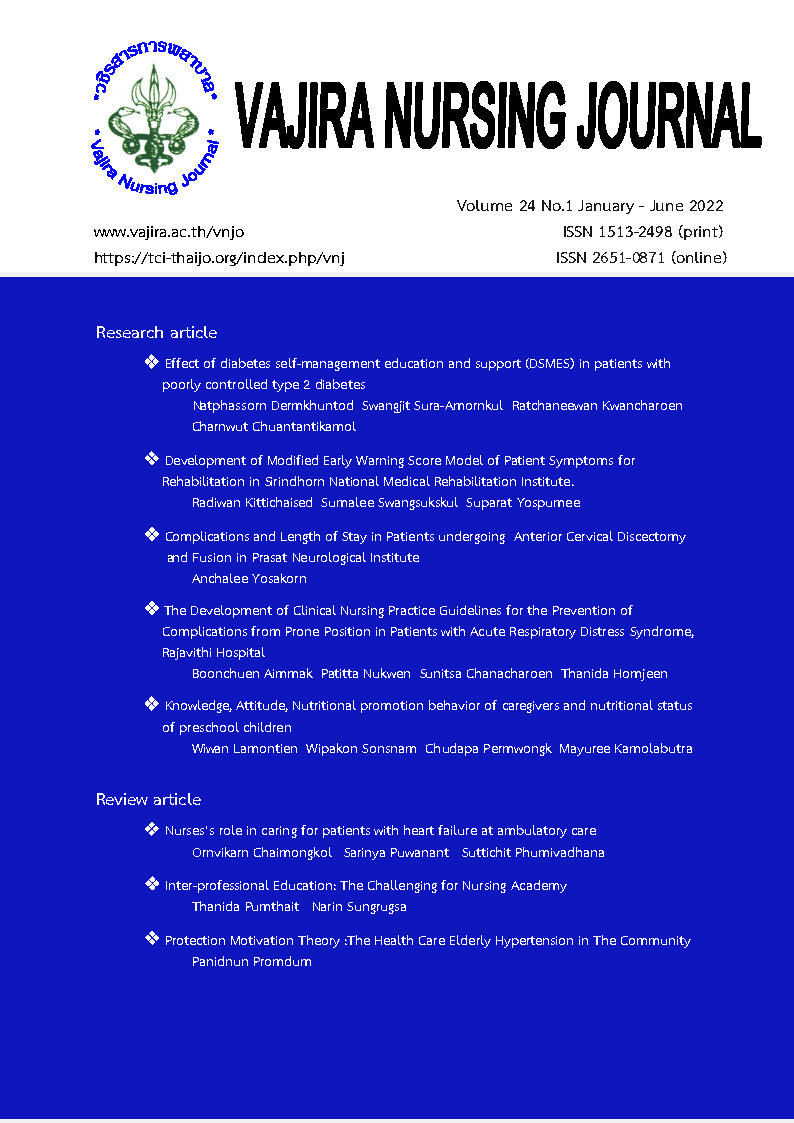การพัฒนาแนวปฏิบัติการพยาบาลทางคลินิกในการป้องกันภาวะแทรกซ้อนจากการจัดท่านอนคว่ำในผู้ป่วยกลุ่มอาการหายใจลำบาก เฉียบพลัน โรงพยาบาลราชวิถี
Main Article Content
บทคัดย่อ
การวิจัยและพัฒนาครั้งนี้มีวัตถุประสงค์เพื่อพัฒนาและศึกษาผลของการใช้แนวปฏิบัติการพยาบาลทางคลินิกในการป้องกันภาวะแทรกซ้อนจากการจัดท่านอนคว่ำในผู้ป่วยกลุ่มอาการหายใจลำบากเฉียบพลัน (Acute Respiratory Distress Syndrome: ARDS) การศึกษานี้ ประกอบด้วย 3 ระยะ ดังนี้ 1) วิเคราะห์สถานการณ์ 2) พัฒนาแนวปฏิบัติตาม Soukup Model (2000) และ 3) ผลลัพธ์ของแนวปฏิบัติฯ นำแนวปฏิบัติฯลงสู่การปฏิบัติด้วยกระบวนการพัฒนาวงจรเดมมิ่ง(PDCA) ในหอผู้ป่วยวิกฤตและกึ่งวิกฤตระหว่างเดือนธันวาคม พ.ศ. 2564 ถึงเมษายน พ.ศ. 2565 กลุ่มตัวอย่าง ประกอบด้วย 1) พยาบาล 40 คน 2) ผู้ป่วย ARDS 10 คน ผลการศึกษาพบว่า 1. แนวปฏิบัติการพยาบาลทางคลินิกในการป้องกันภาวะแทรกซ้อนจากการจัดท่านอนคว่ำของผู้ป่วย ARDS ประกอบด้วย 4 ระยะในการพยาบาล ได้แก่ 1) ก่อนจัดท่านอนคว่ำ 2) ระยะจัดท่านอนคว่ำ 3) ขณะผู้ป่วยอยู่ท่านอนคว่ำ 4) หลังจัดท่านอนคว่ำ 2. ผลการใช้แนวปฏิบัติฯ พบว่าพยาบาลมีคะแนนความรู้และทักษะการพยาบาลฯ เพิ่มขึ้น รวมทั้งมีความพึงพอใจต่อแนวปฏิบัติฯในระดับสูง มีการปฏิบัติตามแนวปฏิบัติฯ ร้อยละ 88.7 และพบว่าอุบัติการณ์ของแผลกดทับบริเวณที่เสี่ยงจากการนอนคว่ำลดลง และไม่มีการเลื่อนหลุดของท่อช่วยหายใจ อย่างไรก็ตาม ควรมีการนิเทศติดตามการปฏิบัติตามแนวปฏิบัติการพยาบาลและนำมาทบทวนเป็นระยะอย่างต่อเนื่อง
Article Details

อนุญาตภายใต้เงื่อนไข Creative Commons Attribution-NonCommercial-NoDerivatives 4.0 International License.
เนื้อหาและข้อมูลในบทความที่ลงตีพิมพ์ในวชิรสารการพยาบาลถือเป็นข้อคิดเห็นและความรับผิดชอบของผู้เขียนบทความโดยตรง ซึ่งกองบรรณาธิการไม่จำเป็นต้องเห็นด้วย หรือร่วมรับผิดชอบใด ๆ ทั้งสิ้น
บทความ ข้อมูล เนื้อหา รูปภาพ ฯลฯ ที่ได้รับการตีพิมพ์ในวชิรสารการพยาบาล ถือเป็นลิขสิทธิ์ของวชิรสารการพยาบาล หากบุคคลใดหรือหน่วยงานใดต้องการนำทั้งหมดหรือส่วนหนึ่งส่วนใดไปเผยแพร่ต่อหรือเพื่อกระทำการใด ๆ จะต้องได้รับอนุญาตเป็นลายลักอักษรจากวชิรสารการพยาบาลก่อนเท่านั้น
เอกสารอ้างอิง
งานเวชระเบียนและสถิติ โรงพยาบาลราชวิถี. (2564). รายงานสถิติผู้ป่วยประจำปี 2563–2564.
จารุณี ทรงม่วง. (2560). การพยาบาลผู้ป่วย Acute Respiratory Distress Syndrome. เวชบันทึก ศิริราช, 10(3), 174-9.
จันทร์เพ็ญ เนียมวัน นารี สิงหเทพ วราทิพย์ แก่นการ. (2563). การพัฒนาแนวปฏิบัติการพยาบาลผู้ที่มีภาวะหายใจลำบากเฉียบพลันที่ใช้เครื่องช่วยหายใจในหอผู้ป่วยหนัก โรงพยาบาลยโสธร. วารสารกองการพยาบาล, 41(1), 105-120.
ราชวิทยาลัยอายุรแพทย์แห่งประเทศไทย. (2544). คำแนะนำ "การสร้างแนวปฏิบัติ" (Clinical Practice Guidelines). สารราชวิทยาลัยอายุรแพทย์แห่งประเทศไทย, 18(6), 36-47.
สถาบันวิจัยและประเมินเทคโนโลยีทางการแพทย์ กรมการแพทย์ กระทรวงสาธารณสุข. (2556). เครื่องมือการประเมินคุณภาพแนวทางปฏิบัติสำหรับการวิจัยและการประเมินผล(Appraisal of guideline for research & evaluation II: AGREE II). นนทบุรี: บริษัท อาร์ต ควอลิไฟท์ จำกัด.
หอผู้ป่วยอายุรกรรม โรงพยาบาลรามาธิบดี กิจกรรมพัฒนาคุณภาพงาน CQI ด้านคลินิก patient care process F-QF-001 rev 5/05-02-63 retrived from https://www.rama.mahidol.ac.th/ km/sites/default/ files/ public/qc/ pdf/166.Safe%20Prone%20Procedure%20for% 20All%20Patients.pdf
Binda, F., Galazzi, A., Marelli, F., Gambazza, S., Villa, L.,Vinci, E., Adamini, I., & Laquintana, D. (2021). Complications of prone positioning in patients with COVID-19: A cross-sectional study. Intensive & critical care nursing, 67, 103088https://doi.org/ 10.1016 /j.iccn.2021.103088.
Donabedian A. (2003). An Introduction to Quality Assurance in Health Care. New York: Oxford University Press.
Drahnak, D. M., & Custer, N. (2015). Prone Positioning of Patients With Acute Respiratory Distress Syndrome. Critical care nurse, 35(6), 29–37.
European Pressure Ulcer Advisory Panel (EPUAP), National Pressure Injury Advisory Panel (NPIAP), Pan Pacific Pressure Injury Alliance (PPPIA). Prevention and treatment of pressure ulcers/ injuries: clinical practice guidelines. The international guideline. 3rd ed. Emily Haesler, editor. EPUAP, NPIAP, PPPIA; 2019.
Johnson, C., Giordano, N. A., Patel, L., Book, K. A., Mac, J., Viscomi, J… Mastro, K. A. (2022). Pressure Injury Outcomes of a Prone-Positioning Protocol in Patients With COVID and ARDS. American journal of critical care : an official publication, American Association of Critical-Care Nurses, 31(1), 34–41.
Guérin, C., Beuret, P., Constantin, J. M., Bellani, G., Garcia-Olivares, P., Roca, O.,…Chrétien, J. M. (2018). A prospective international observational prevalence study on prone positioning of ARDS patients: the APRONET (ARDS Prone Position Network) study, Intensive care medicine, 44(1), 22–37.
Ponseti,J.E., Millán, V.A., & Chinchilla, O.D. (2017). Analysis of complications of prone position in acute respiratory distress syndrome: quality standard, incidence and related factors. Análisis de las complicaciones del decúbito prono en el síndrome de distrés respiratorio agudo: estándar de calidad, incidencia y factores relacionados. Enfermeria intensiva, 28(3), 125–134.
Mittermaiera M, Pickerodtc P, Kurtha F, Bosquillon L, Uhriga A, Garciaa C, et al. (2020). Evaluation of PEEP and prone positioning in early COVID-19 ARDS. EClinical Medicine.2020, 28,100579, Retrieved from https://doi.org/10.1016 /j.eclinm. 2020.100579.
Moore, Z., Patton, D., Avsar, P., McEvoy, N. L., Curley, G., Budri, A., … O'Connor, T. (2020). Prevention of pressure ulcers among individuals cared for in the prone position: lessons for the COVID-19 emergency. Journal of wound care, 29(6), 312–320. https://doi.org/10.12968/ jowc.2020.29.6.312
Oliveira, V. M., Piekala, D. M., Deponti, G. N., Batista, D., Minossi, S. D., Chisté, M.,…Vieira, S. (2017). Safe prone checklist: construction and implementation of a tool for performing the prone maneuver. Checklist da prona segura: construção e implementação de uma ferramenta para realização da manobra de prona. Revista Brasileira de terapia intensiva, 29(2), 131–141.
Polit D. & Beck CT. (2004). Nursing Research: Principles and Methods. (7th ed.). Philadelphia: Lippincott Williams & Wilkins.
Soukup M. (2000). The center for advanced nursing practice evidence based practice model. Nurs Clin North Am., 35(2), 301-9.
Tzotzos, S. J., Fischer, B., Fischer, H., & Zeitlinger, M. (2020). Incidence of ARDS and outcomes in hospitalized patients with COVID-19: a global literature survey. Critical care (London, England), 24(1), 516. https://doi.org/10.1186/s13054-020-03240-7.
Ware, L. B., & Matthay, M. A. (2000). The acute respiratory distress syndrome. The New England journal of medicine, 342(18), 1334–1349.https: //doi.org/10.1056/NEJM200005043421806


